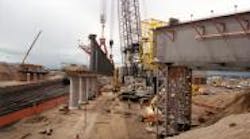“The ‘America's Transportation Award’ competition allows us to honor and recognize projects that save taxpayers money, offer new and innovative ideas to the industry that help every driver, and make our commutes easier and safer.” –John Horsley, executive director, American Association of State Highway and Transportation Officials (AASHTO)
We often talk about what’s wrong with our transportation infrastructure in this country, so it’s a refreshing change of pace to take a look at what’s going right with it once in a while.
That’s the point of the annual America's Transportation Awards competition, put together by the American Association of State Highway and Transportation Officials (AASHTO), AAA, and the U.S. Chamber of Commerce.
A total of 40 transportation infrastructure projects from 29 states were judged according to three basic criteria: “On Time,” “Under Budget,” and “Innovative Management.”
From those 40 entrants, a “top 10” list of finalists has emerged based on obtaining highest number of overall points during four regional contests. From those 10, a “grand prize” and “people’s choice” winner will be named Oct. 16 during AASHTO’s annual meeting in Detroit.
[Here’s a video clip reviewing the list of finalists.]
Here are a few more details about why these 10 got selected as the “best of the best” in terms of exemplifying the right ways to conceive and complete massive transportation infrastructure projects:
• Florida – I-10 to I-95 Interchange: "The Big I" finished six months ahead of schedule, with the Florida Department of Transportation reconstructing the I-10/I-95 interchange, a project that consisted of 17 bridges, 21 ramps, and 25 lane miles built over and around traffic moving through one of the busiest interchanges in the state. Countless taxpayer dollars and commuting headaches were saved.
• Kansas – K-23 Practical Improvement project: Time and taxpayer money were saved when the Kansas Department of Transportation used practical design strategies to rebuild 17 miles of a two-lane road in western Kansas. The project removed deteriorated asphalt and widened the road as well.
• Kentucky – Newtown Pike Extension: In order to accommodate the 2010 World Equestrian Games, the Kentucky Transportation Cabinet had to extend the Newtown Pike in a very short period of time. The project, designed to improve traffic flow into downtown Lexington, finished on schedule, two full weeks before the Games, even with unanticipated work added to the project.
• Massachusetts – Phillipston Heavy Lift Bridge Replacement: This $3.3 million project by the Massachusetts Highway Department became the fastest bridge replacement in state history when it used Self Propelled Modular Transporters for bridge replacement for the first time.
• Michigan – The Fix on I-196 project: This $40 million project by the Michigan Department of Transportation used more than 100 community meetings and significant public partnership efforts that enabled the completion of the two-mile segment of I-196 near Grand Rapids during a single construction season.
• Montana – Shiloh Road: This project by the Montana Department of Transportation improved safety and mobility along a 4.5-mile stretch of Shiloh Road, formerly a quiet dirt road that had grown into a critical commuter corridor. The $25 million project kept the road open with very few detours and delays.
• New Hampshire – Hampton Toll Plaza conversion to open road tolling: This $17 million New Hampshire Department of Transportation project to convert to open-road tolling was competed on a fast-tracked, 16-month schedule, after it was determined that the 16-lane toll plaza did not have adequate capacity to handle seasonal traffic demands.
[Here's an example from Florida about how "open road tolling" functions.]
• South Carolina – Plans Online project: South Carolina Department of Transportation saved time and taxpayer money by creating a database of 1.9 million digitally scanned image files of roadway construction plans, available at the click of a button online. This 13-year project replaced the old, cumbersome method of reviewing plans in person.
• Utah – SR-171 3500 South Reconstruction: The $41 million Utah Department of Transportation project rebuilt 1.2 miles of urban arterial, converting it from a 5-lane road into an 8-lane boulevard that serves as the major east/west transportation corridor for the Salt Lake Valley without disrupting local businesses.
• Washington – Operation I-5 Partnership to Relieve Congestion: The Washington State Department of Transportation encouraged a coalition of organizers to join forces to creatively solve the traffic problem that stretched for miles through a military base nestled between Tacoma and Olympia, an area seeing robust growth in economy and population.
It’s worthy to note in all of this just how hideously expensive transportation infrastructure projects are nowadays. Look at Utah’s reconstruction project as but one example, where rebuilding 1.2 miles of urban roadway as well as expanding it from five to eight lines came with a whopping $41 million price tag. And this is one of the most cost-efficient transportation infrastructure projects in the nation!
That just illustrates that rebuilding and improving our transportation networks in this country of ours is going to take a lot of creative, innovative thought, if only to find ways to keep the costs down.



